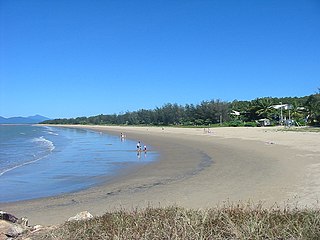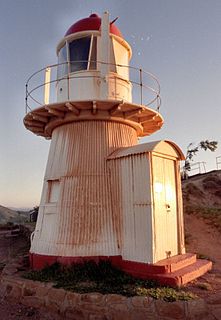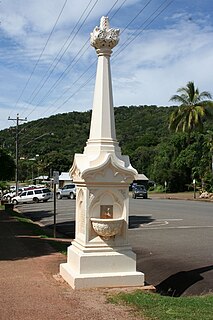
Lizard Island is an island on the Great Barrier Reef in Queensland (Australia), 1624 km northwest of Brisbane and part of the Lizard Island Group that also includes Palfrey Island. It is part of the Lizard Island National Park. Lizard Island is within the locality of Lizard in the Cook Shire.

Green Island is an island and locality in the Cairns Region, Queensland, Australia.
The Manbarra, otherwise known as the Wulgurukaba, are Aboriginal Australian people, and the traditional custodians of Palm Island in Queensland.

Yorkeys Knob is a coastal suburb of Cairns, in Cairns Region, Far North Queensland, Australia. It is approximately 13 kilometres (8.1 mi) north of the centre of Cairns, and is the third beach suburb after Machans Beach and Holloways Beach.
Suzanne Falkiner is an Australian writer.

Cooktown is a coastal town and locality in the Shire of Cook, Queensland, Australia. Cooktown is at the mouth of the Endeavour River, on Cape York Peninsula in Far North Queensland where James Cook beached his ship, the Endeavour, for repairs in 1770. Both the town and Mount Cook which rises up behind the town were named after James Cook.

Mary Watson, was an Australian folk heroine. She was 21 years old and had been married less than eighteen months when she died of thirst on No. 5 Island in the Howick Group now called Watson’s Island north of Cape Flattery in Far North Queensland, Australia, in 1881. She, with her four-month-old baby, Ferrier, and a wounded Chinese workman, Ah Sam, had drifted for eight days and some forty miles in a cut-down ship's water tank, used for boiling sea slugs, after mainland Aboriginal people had attacked her absent husband's bêche de mer station on Lizard Island. Her diary describing their last days was found with their remains in 1882, and Watson became an emblem of pioneer heroism for many Queenslanders.

Grassy Hill Light, also known as Cooktown Light, is an active lighthouse located on Grassy Hill above Cooktown, Queensland, Australia, on the south side of the entrance to Endeavour River.

The Industrial ruins are a heritage-listed archaeological site at Cliff Terrace, Macleay Island, City of Redland, Queensland, Australia. It was built from c. 1869 to c. 1871. It was added to the Queensland Heritage Register on 6 April 1998.

James Sangster Memorial is a heritage-listed memorial at Browns Park, Downs Street, North Ipswich, City of Ipswich, Queensland, Australia. The memorial was erected to commemorate the heroism of police constable James Sangster who drowned attempting to save two people. It was designed and built in 1898 by C Wilson & Co. It was added to the Queensland Heritage Register on 18 September 2008.

St Mary's by the Sea is a heritage-listed non-denominational church at Wharf Street, Port Douglas, Shire of Douglas, Queensland, Australia. It was built from 1913 to 1914. It is also known as the former St Mary's Roman Catholic Church. It was added to the Queensland Heritage Register on 21 October 1992.

Mary Watson's Monument is a heritage-listed memorial at Charlotte Street, Cooktown, Shire of Cook, Queensland, Australia. It was designed and built by Ernest Greenway in 1886. It was added to the Queensland Heritage Register on 21 October 1992.

Cook Shire Council Chambers is a heritage-listed former town hall and now museum at 121 Charlotte Street, Cooktown, Shire of Cook, Queensland, Australia. It was built from 1876 to 1877 by Henry J Meldrum and John Sullivan. It was also known as Cooktown Post and Telegraph Office and is now known as Cooktown History Centre. It was added to the Queensland Heritage Register on 8 April 1997.

Cooks Monument and Reserve is a heritage-listed memorial at Charlotte Street, Cooktown, Shire of Cook, Queensland, Australia. It was designed in the office of the Queensland Colonial Architect and built by Hobbs and Carter in 1887. It was added to the Queensland Heritage Register on 30 April 1997.

Cooktown Cemetery is a heritage-listed cemetery at Charlotte Street, Cooktown, Shire of Cook, Queensland, Australia. It was built from 1874 to 1920. It was added to the Queensland Heritage Register on 8 April 1997.

Seagren's Building is a heritage-listed workshop at 124 Charlotte Street, Cooktown, Shire of Cook, Queensland, Australia. It was built from 1880s to c. 1900. It is also known as Motor Inn Motel and Seagren's Inn. It was added to the Queensland Heritage Register on 21 October 1992.

Ferrari Estates Building is a heritage-listed former bank building at 126 Charlotte Street, Cooktown, Shire of Cook, Queensland, Australia. It was designed by Eyre & Munro and built from 1890 to 1891 by John Armstrong. It is also known as Bank of North Queensland. It was added to the Queensland Heritage Register on 21 October 1992.

Holy Trinity Church is a heritage-listed Anglican church at Saibai Island, Torres Strait Island Region, Queensland, Australia. It was built from 1926 to 1938. It is also known as Holy Trinity Church of England. It was added to the Queensland Heritage Register on 21 October 1992.

Our Lady of the Sacred Heart Church is a heritage-listed Roman Catholic church at 120 Douglas Street, Thursday Island, Shire of Torres, Queensland, Australia. It was built from c. 1885 to c. 1905. It was added to the Queensland Heritage Register on 7 December 1998.

All Saints Anglican Church is a heritage-listed church at Darnley Island, Torres Strait Island Region, Queensland, Australia. It was built from 1919 to 1938. It was added to the Queensland Heritage Register on 21 October 1992.






















